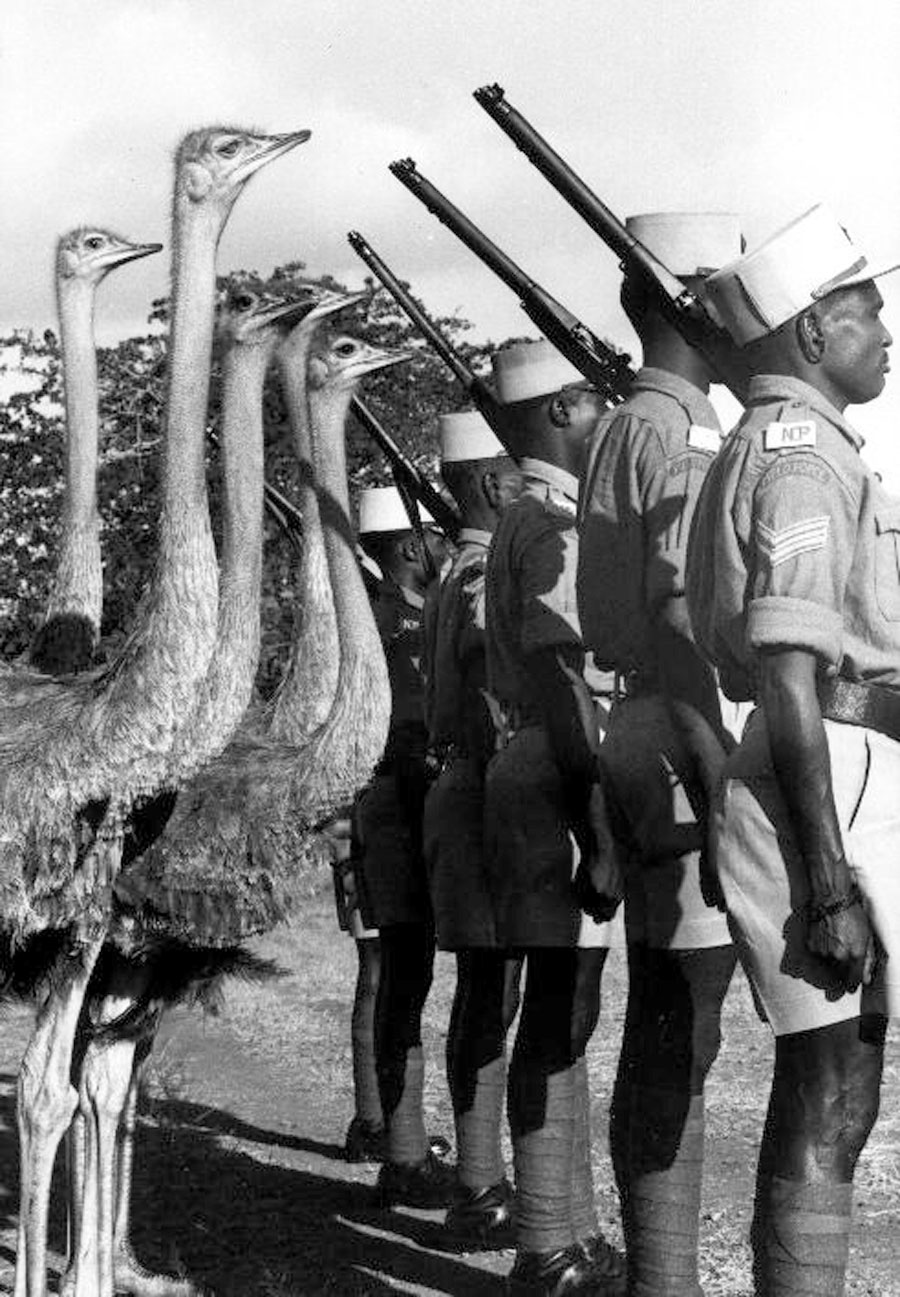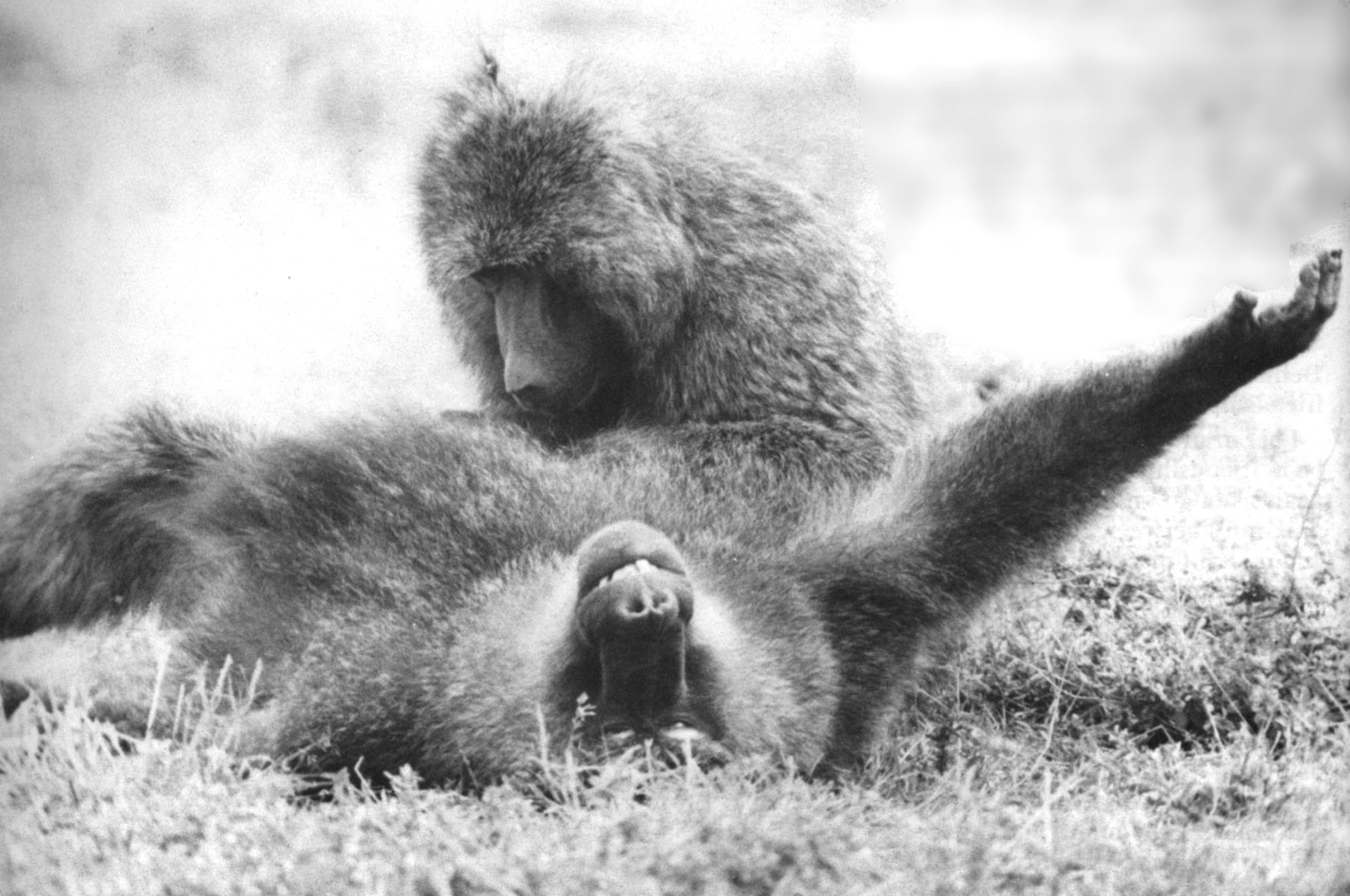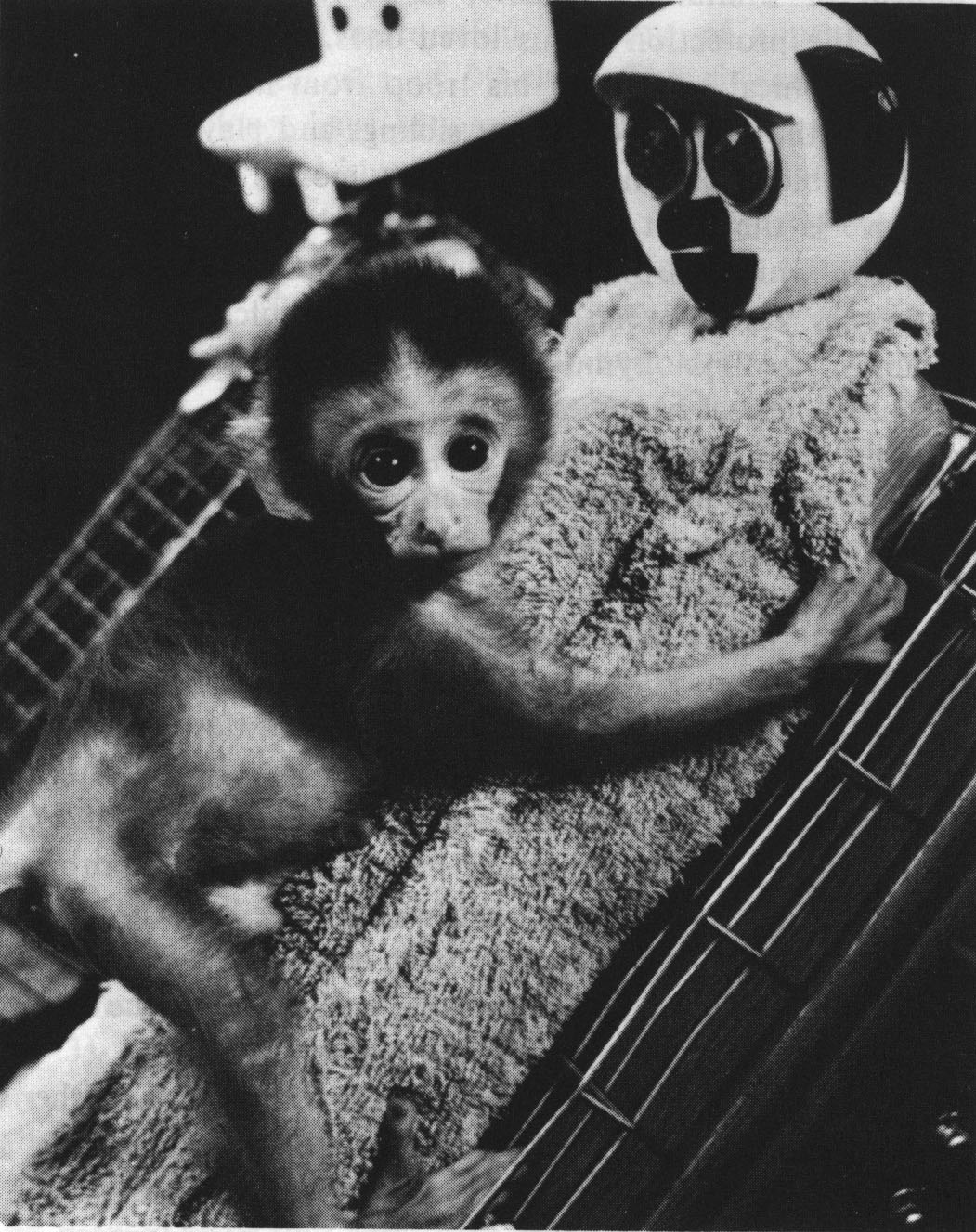Copyright © 2007-2018 Russ Dewey
Prosocial (Friendly) Interactions
Invitation displays among group-living animals are ways of inviting friendly interaction. Long-necked birds such as ostriches commonly crane their necks upward and gather in a friendly group, as if engaging in a dance.
What is the function of an invitation display?
The photographer Marion Kaplan observed a group of ostriches apparently attracted by the upright rifles of marching soldiers.

Free ranging ostriches lined up behind soldiers
The event took place in Tsavo National Park in Kenya, in 1969. "A group of park rangers were practicing their drill as several ostriches, wild but used to human presence, wandered near by. Quite soon the ostriches, unherded and without encouragement, were in a tidy line behind the rangers. Their mood was curious, playful, imitative, not at all threatening" (Marion Kaplan, personal communication).
Kaplan adds that the rangers enjoyed the ostriches, but higher authorities disapproved. Ultimately the two groups were separated.
How do dogs and cats typically react to contact with the vulnerable underbelly area?
Grooming is a common prosocial activity, so group-living animals commonly use a posture suitable for grooming as an invitation display. Dogs who like to be scratched on their bellies may convert the universal canine submission posture (lying on the back) into an invitation display.
Dogs expect to be scratched by a friendly human in this position, particularly if they have a history of belly rubs. With cats, that posture is more ambiguous.
Cats use lying on the back to indicate peaceful intentions, but (with rare exceptions) they do not use it as an invitation display. For cats, showing the underbelly is an appeasement gesture, showing trust and affection but not inviting contact. Therefore, cats normally do not like a human touching their underbelly fur.
People who own dogs sometimes misinterpret a cat's display of belly fur as an invitation posture. Thinking the cat wants to be scratched, they reach down to scratch the cat. To most cats, that is a violation! The cat bites or scratches or flees.
Several students informed me of exceptions to this rule. Perhaps their cats were raised from early kittenhood to expect belly rubs.

A dog may lie on its back as an invitation display to invite grooming by a human. Cats use the same display as a submission posture and may react badly to contact with their exposed underbelly fur.
Monkeys solicit grooming from other monkeys by presenting their backs. If the other monkey is interested in a grooming session, it will pick through the presenting monkey's back fur, removing dirt or insects. After a while the grooming monkey will turn and display its back to the other, which will groom it in turn.
What is a typical pattern of mutual grooming, in monkeys?

Pandora grooms Virgil (photograph: Barbara Smuts, used by permission)
Psychologist Barbara Smuts (1986) spent three years living with baboons to study their prosocial behavior. The picture shows Pandora grooming Virgil. You can see Virgil's blissful expression. Virgil's belly fur was being groomed.
Smuts used the technique of habituation. She spent every day with the baboon troop but refused to interact with them. Eventually the baboons simply ignored her and went about their business.
How did Smuts interact, or not interact, with the baboons?
Smuts documented many examples of prosocial behaviors. She found that long-term friendships and alliances often extended to different age groups, such as parents and children. The blissful scene of Virgil and Pandora above was soon transformed into a scene of play.
After a few moments they were joined by two of Pandora's offspring... Pyrrha was in a rambunctious mood, and she used Virgil's stomach as a trampoline, bouncing up and down with the voiceless laughter that accompanies baboon play.
Every now and then Virgil opened his half-shut eyes, and, gently touching her with his index finger, he grunted as if to reassure her that he did not mind the rhythmic impact of her slight body against his full stomach. (Smuts, 1986, p.4)
Despite refusing to interact with the baboons, Smuts became accepted as if she was a friend. "Once I fell asleep surrounded by 100 munching baboons only to awaken half an hour later, alone, except for an adolescent male who had chosen to nap by my side.
"We blinked at one another in the light of the noonday sun and then casually sauntered several miles back to the rest of the troop, with him leading the way." (Smuts, 2003)
Contact Comfort
Harry Harlow, whose learning-to-learn experiments we reviewed earlier, set up one of the nation's best-equipped primate laboratories at the University of Wisconsin. There he did a famous series of experiments focused on contact comfort in baby monkeys (Harlow and Harlow, 1962).
Harlow raised rhesus monkeys from birth. He thought it was necessary to keep young monkeys separate from each other for health reasons. This separation began soon after birth.
Harlow noticed that young monkeys deprived of contact with their mothers appeared to suffer mental distress. The babies became very attached to cheesecloth diapers in their cages, clinging onto them like security blankets.
What vision did Harlow have while on a champagne flight over Detroit?
As the story goes, Harlow was on a champagne flight over Detroit in 1957, wondering which would be more powerful, contact comfort or food. Suddenly he got the idea of providing the babies with a choice between two mothers, one providing something soft to embrace, the other providing milk.
To make a cuddly mother, Harlow's assistants covered a wire frame with terrycloth. A second mother was identical to the first but had no terrycloth. It was just a wire frame with a built-in milk bottle and nipple.
Harlow found that baby monkeys preferred the terrycloth mother, spending as little time as possible on the wire frame mother. Contact comfort was more important than food, except when the baby monkey was actually eating.
What finally made babies reject the Terrycloth mother?

A baby rhesus monkey clings to the terrycloth mother
Harlow found baby monkeys were very forgiving of their terrycloth mothers. One "mother" was designed to occasionally catapult the baby off, throwing it to the other side of the cage. But the babies always came back.
Another had spikes beneath her terrycloth, but the babies put up with the pain. The only manipulation that made babies abandon a terrycloth mother was running cold water through tubes inside the mother, making the body cold. Then the baby monkeys rejected it and retreated to a corner of the cage.
Harlow found that the monkeys who grew up without proper parenting showed lasting signs of emotional disturbance. They were unable to provide proper parenting themselves when they got older: a finding with clear implications for human society.
If you think Harlow's research sounds rather unfeeling and cruel, you are not alone. Harlow became bete noire for the animal rights movement. The fact that he was a notorious alcoholic did not help. Many people were astonished that he was willing to tolerate so much suffering in his research subjects.
In 2016, research remarkably similar to Harlow's (taking baby rhesus macaques away from their mothers and addicting them to alcohol) was conducted at a National Institutes of Health lab. This time, 55 years after Harlow, there were protests, ultimately leading the NIH to "review the ethical policies and procedures surrounding work on monkeys, baboons, and related animals." The year before, in 2015, The NIH ended all support for invasive chimp research in the U.S.
Animal researchers reacted defensively against pressure by animal rights organizations. Researchers noted the importance of animal research for developing vaccines against threats such as ebola and the zika virus.
However, many universities were closing primate labs. Ohio State closed their chimpanzee research center in 2006, interrupting the research of Sarah Boysen. Harvard closed the New England Primate Research Center (NEPRC) located in Southborough, Massachusetts in 2015.
In Harlow's defense, his research showed the importance of touch and cuddling for basic nurturance of primate babies. That had many positive consequences. For example, it encouraged research on positive effects of touch and massage on human babies.
Researchers like Tiffany Field identified several positive effects of touch and massage on premature human infants. It is now standard practice in the U.S. to given premature infants daily treatments of massage and cuddling.
Play
Fagen (1983) pointed out that play expends energy and creates a risk of injury. Therefore it must have counterbalancing benefits. Otherwise it would not be positively selected in evolution.
What is the adaptive function of play? One hypothesis born out by field studies is that social bonds formed in childhood might be helpful later in life.
Smuts, who took the picture of Pandora grooming Virgil the baboon, found friendship appeared to be helpful to baboons. Friendships formed in childhood lasted into adulthood.
What are benefits of play?
Another obvious benefit of play is that it exercises and refines skills to be used in adulthood. Byers (1981) noted:
Most play is vigorous, repeated, and often spectacular exercise. Repeated performance of motor tasks in mammals results in a physiological "training response" in which muscles and bones hypertrophy [grow stronger], endurance increases, and the economy and precision of the movements increase.
...In the few species studied, play accounts for almost all vigorous exercise performed by young animals and...many aspects of playfighting are strikingly congruent with exercise programs designed to develop skill in humans. (p.1494)
Play is often repetitious, and often the play behavior is not carried to its usual conclusions. For example, in play-biting the mouth is not closed. Play is often exaggerated in form (e.g. the bounding of a kitten, the jumping of baby goats).
Social play (pouncing, rough-housing) is often preceded by a stereotyped pose or behavior indicating a lack of serious aggression or intention to harm. Rhesus monkeys have a play-face they make before bothering an adult. Dogs display a distinctive posture with forelegs on the ground as a play signal.
How do young animals signal that play attacks are not serious? How do adults start episodes of play with youngsters?
Hinde (1970) pointed out that play behavior is often elicited by an older animal. The lioness twitches her tail and cubs play with it.
Female chimpanzees tickle and roll their infants while pretending to bite them. Playing with young offspring is evidently pleasurable to adults, too, in moderate amounts. These behaviors are mutually reinforcing.
Reproductive Activity
Reproductive activity has always been a focus of scientists studying animals because it forms such a prominent part of the behavioral repertoire of all species. Most acts of most animals are geared, ultimately, toward production of successfully reproducing young.
Odor is a widely used form of communication in the animal world. It is especially useful for tracking or attracting a mate.
Odor bearing molecules are both durable and highly specific. They convey directional information if carried in the air or water. To find the source of an odor, animals go where it is strongest.
Salmon use odor as a homing signal before spawning (laying eggs). This drive is so powerful that salmon will beat themselves to death against a dam if one is built across a stream between the spawning pond and the sea.
How do salmon find their home stream during spawning?
Scientists wondered how salmon found their way back hundreds of miles to the same exact pond where they were born. It turned out odor was the key.
Scientists put a few drops of a chemical with a powerful odor in a spawning pond. When the salmon were grown up and returned from the sea, the scientists put the chemical in a new, different pond.
The salmon went back to this new, different pond. A similar experiment showed that frogs return to a pond with the same odor as where they were born.
What is a pheromone?
Odors called pheromones play a role in mating activity. Technically, a pheromone is an intraspecific distance hormone, which means it is a chemical used within a species (intraspecific) to communicate at a distance.
A pheromone is not necessarily a sexual attractant. Insect responses to odor include swarming, grooming, exchanging solid foods and exchanging liquids.
A few parts per billion of a pheromone floating in the air can trigger a response. For example, male dogs will travel many city blocks to find a female dog that is sexually receptive (in heat) and emitting pheromones.
Do humans respond to pheromones for sexual attraction? The makers of the fragrance Andron claimed it had pheromone-like effects on the opposite sex, although the chemist who designed Andron said he did not believe it.
The vomeronasal organ in the nose of humans may possibly be involved in pheromone-like sexual attraction. However, so far, nobody has shown a consistent human response of romantic interest in response to a specific odor.
Social status often has a direct impact on reproductive success. Less dominant animals may be excluded from mating entirely. Tournaments where males gather to compete for dominance are common in many species. The winners get the healthiest, highest ranking mates.
That does not prevent lower status animals from trying to reproduce, but they may not be successful. In many group-living species, males who fail to achieve a dominant position are relegated to the outskirts of a communal territory or banished altogether.
When humans try to breed domesticated animals, they often do so without regard to the status relationships worked out between animals in a social group. That can backfire. Watson (1975) explains:
Apparently, a class structure is strong among sheep, and mating is related to dominance. A dominant ram mates best with a dominant ewe, a less dominant ram with a less dominant ewe, and so on, down to the least dominant sheep.
However, when a lone ram is released among a flock of ewes, he will invariably attempt to mate with the ewe that is most obviously at the height of estrus. But she will probably reject him if he is not at the right dominance level (Watson, 1975).
New Zealand researchers found they could improve the fertility of flocks by sending a whole group of rams into a flock of ewes, instead of sending them into the flock by themselves. Under these more natural conditions, rams found ewes at their own level of dominance, and more lambs resulted.
---------------------
References:
Byers, J. (1981). The significance of play. Science, 212, 1493-1494.
Fagen, R. (1983, December). Horseplay and monkey-shines. Science 83, pp.70-76.
Harlow, H. F. & Harlow, M. K. (1962, November). Social deprivation in monkeys. Scientific American, 207, 136-46.
Hinde, R. A. (1970) Animal Behaviour. New York: McGraw-Hill.
Smuts, B. (1986, Fall) Sex and friendship in Baboons. LS&A, p.4.
Smuts, B. (2003) Reflections. Chapter 9 In S. J. Armstrong & R. G. Botzler (Eds.), The Animal Ethics reader. London: Routledge.
Watson, P. (1975, December). Boss cows and sleepy, sexy sheep. Psychology Today, p.93.
Write to Dr. Dewey at psywww@gmail.com.
Don't see what you need? Psych Web has over 1,000 pages, so it may be elsewhere on the site. Do a site-specific Google search using the box below.
